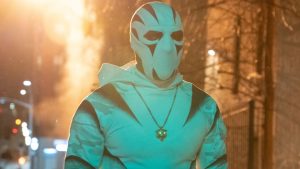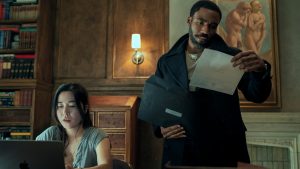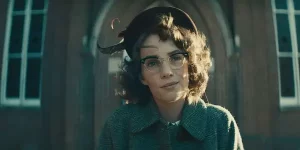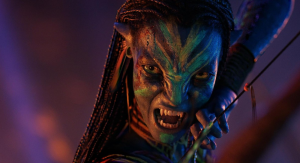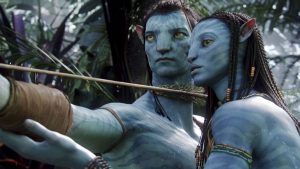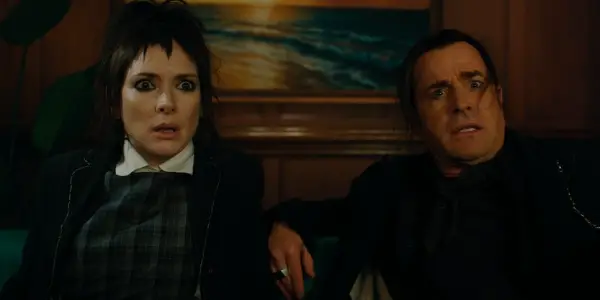
Once a proud young artist pioneering the exploration of the pop-macabre and the surreal, Tim Burton appears to have become a ghost of his former self. There are few, if any, traces of the iconic filmmaker in 2024’s Beetlejuice Beetlejuice.
Back in 1988, Burton was a struggling indie filmmaker, fresh off Pee-wee’s Big Adventure but not yet a household name. Beetlejuice represented a creative coup for Burton, a rejection of the idiotic Hollywood scripts he was sent after Pee-wee’s success and a proof of concept for his brand of paranormal hijinks, anti-consumerist satire, and twisted scares. Beetlejuice was an artistically empowering work that both parodied the self-indulgent artists Burton avoided and ridiculed the capitalist cattle yard that America had become — and yet, after years of slowly selling out, Burton seems to have become numb to both these powers, to both ego and capital. And so, behold his Beetlejuice Beetlejuice, a sad eulogy to a shriveled dream.
It’s Been 36 Years….
Things have been rough since Hollywood studios have started resurrecting hits from the 1980s and ’90s. I feel like this trend of long-awaited sequels never prioritizes new ideas, only revamped versions of old ones. Beetlejuice Beetlejuice follows in this trend, being both a continuation of the first film’s story and also basically just the first story all over again. In every scene, déjà vu lingers in the air like stale fog from a Halloween smoke machine. We are shown the same characters, the same house, the same conflicts, and some of the same jokes. It’s not quite “Chewie, we’re home” levels of fan service, but it sure comes close. If the first Beetlejuice felt like a fucked-up dollhouse of sandworms, shrunken heads, and Calypso music, the second Beetlejuice only does some light redecorating but never tries to break the mold.
Beetlejuice Beetlejuice reintroduces us to Lydia Deetz (Winona Ryder), who is sporting the same triangle-bangs hairstyle 36 years later as a TV huckster medium. (The hairstyle is very distracting.) She hosts a crummy network show about ghost-hunting and communicating with the dead, like if Ghost Hunters had segments filmed in front of a live studio audience with set dressings lifted straight from Elvira’s Movie Macabre. Odd that Lydia, the nihilistic goth character in Beetlejuice who represents teen rebellion and struggles the whole movie for freedom, becomes a sellout TV host and still maintains a good relationship with her parents. It’s one in a long line of script decisions that feel like they undermine the message and purpose of the original Beetlejuice.
source: Warner Bros.
Lydia is quickly entwined in Deetz family drama once again. Her father, Charles (Jeffrey Jones), is dead, and her mom, Delia (Catherine O’Hara), brings the Deetzes back together — including Lydia’s producer/boyfriend (Justin Theroux) and her daughter, Astrid (Jenna Ortega). They gather at the house on the hill to hold a service for Charles and put old spirits to rest. Of course, this being a product of 2020s Hollywood, Beetlejuice 2 is set in the same house as the first movie.
Beetlejuice himself is back, again played by Michael Keaton, bless his soul. The Juice still operates a bio-exorcist service in the afterlife, and in this film, we see his office, staffed by a dozen ghoulish employees with shrunken heads. His plot involves the Deetzes and his deceased bride (Monica Bellucci), who has stapled her body back together to exact soul-sucking revenge on Beetlejuice. Hot on her trail is supernatural detective Wolf Jackson (Willem Dafoe), and Dafoe doesn’t have much to do besides posture with a gun, have fun, and call Beetlejuice “Mr. Juice.” Sometimes, that’s all you need in a movie.
Why Bring Back The Deetzes?
There’s an old adage in storytelling that you need to find your characters at the most important time in their lives; the challenge with a sequel is that now, the writer needs to invent a second most important time in their lives. I understand that Astrid’s first encounter with the supernatural is a big deal for her, but she doesn’t have the sort of arc that Lydia does in Beetlejuice — Astrid is curiously removed from much of this sequel’s action. She’s the fourth most-important character in a film that doesn’t really care about characterization.
Why has the Deetz family returned? Why has the house returned, or the town of Winter River for that matter? The original movie isn’t called Lydia Deetz — it’s called Beetlejuice. The only character who needs to be in the sequel is the demon, and everyone else is secondary. Beetlejuice Beetlejuice feels like the worst version of itself, and the screenplay feels, to me, like that really obvious, fan service-y script that got written and tossed out early into the film’s development. It’s more fan fiction than a serious story. It’s endlessly self-referential and embarrassingly indulgent, so committed to recapturing the energy of the first film but unsure of how to do that without bringing back the stuff audiences have already seen.
source: Warner Bros.
I would forgive the choice to bring back the Deetzes were it not for the performances. Winona Ryder and Catherine O’Hara are good actors and have proven that time and again. But neither star fits Beetlejuice Beetlejuice. Their characters are obnoxious, Lydia and Delia seem to have learned no lessons from Beetlejuice, and Ryder and O’Hara get far too cartoony. They’re playing to the cheap seats. Every quirk is overemphasized, and every emotion is delivered at 110% — this especially goes for O’Hara, who spends much of the picture shrieking and yelling. I expected this mugging from Keaton, for whom every scene as Beetlejuice plays like a carefully rehearsed, grotesque stand-up routine. But Lydia, our point-of-view human character in Beetlejuice, is supposed to be more grounded, so it feels disingenuous and wrong to see Ryder reading her lines while constantly tilting her head to the left, then to the right, then angling her chin up and down, then squinting with one eye and then the other. She does not act like a human being. She acts like Bugs Bunny just drank a jar of poison and is sputtering across the kitchen.
The physical performances feel phony, too — in one scene, Lydia arrives mere seconds too late to save her daughter, and she races to stop Astrid from stepping through a portal into the ghost world. But either due to poor direction or issues with the set, Ryder doesn’t run so much as she ambles over to the portal. Too many scenes have these unhurried physical performances, and they feel like high school theater — you can imagine Burton watching the dailies and thinking to himself that he can just fix this in post.
Of all the Deetzes to bring back for the sequel, Charles’ inclusion is the most questionable. Actor Jeffrey Jones does not return — he was arrested in 2002 for possession of child pornography and is now a registered sex offender. Jones’ character, therefore, is brutally killed off. Some critics have praised the film’s gruesome offing of Charles, interpreting it as some sort of condemnation of Jones and his actions. But really, Jones features in Beetlejuice Beetlejuice far too much for my liking. The actor’s likeness is used multiple times — not only for funeral photos, but also in claymation scenes where we see Charles die. Surely some entertainment attorney worked hard to make sure Jones was compensated for these instances. Lydia, Astrid, and Delia only speak lovingly about his character, and Delia’s entire storyline focuses on mourning Charles’ death. It’s like if we got a new Lethal Weapon movie where half the plot is characters talking about how great and noble and not anti-Semitic Mel Gibson’s character was. It doesn’t feel as though Jones was omitted from the production because of the actor’s disgusting behavior; it feels like Burton and company are legitimately upset that they didn’t get to work with him again. I just can’t tell whether it’s an artistic failing of the movie to not distance itself more from a sex offender or if it’s a case of personal bias. Either way, if Jones’ reputation skeeves you out, Beetlejuice Beetlejuice has no pity for you.
Beetlejuice Beetlejuice’s New Characters
I don’t think Beetlejuice Beetlejuice is a complete disaster. The new characters and storylines work, especially Dafoe’s afterlife detective, who spends the climax somersaulting between gravestones and posing with a pistol in a really cool way. Astrid’s storyline is the most original departure from the first film. It involves a new boy, Jeremy (Arthur Conti), in Winter River, who loves Dostoevsky and listens to records on vinyl. An instant heartthrob. This is Conti’s first feature film role — and before you ask, of course he’s a nepo baby — but he’s handsome, charming, and sells all the layers to his character. He has that adorable messy curly hair and long neck that make him look a bit like a sad llama. He also looks a lot like a dude on the wall at my gym.
Introducing: The guy on the wall at my gym.
Justin Theroux is another welcome addition to the ensemble. He brings such believable douchey zaniness to every scene he’s in, and the talented actor, known for HBO’s The Leftovers and David Lynch’s Mulholland Dr., takes what could have been a tired cliché and turns him into a manic, essential member of the cast. Every scene is better for having him in it — Theroux just gets it.
One incredible actor who gets short shrift in Beetlejuice Beetlejuice is Burn Gorman. Playing a priest in Winter River, he appears briefly during the funeral and then in the climax. Gorman, like many other übertalented English actors today, mostly appears in bit roles in genre or period films. He’s a henchman in Enola Holmes and The Dark Knight Rises, and he’s probably in Game of Thrones. Every English actor was, at some point. Anyway, he has the weirdest line deliveries throughout this movie, and his creeping demeanor and caruncular head posture make the priest one of the most natural, unnatural characters in the world of Beetlejuice. In the inevitable big musical number, when the possessed priest is forced to sing against his will, Gorman does the most impressive acting of anyone in the entire film with just his fishy mouth and his scared, darting eyes.
Everything new in Beetlejuice Beetlejuice is great and reminds you why you loved Tim Burton in the first place. At their best, his films are unpretentious, aesthetically rich, and charming, and his kooky arabesque dominates the afterlife scenes especially. He could have easily surrendered to empty computer-generated environments or just replicated the afterlife sets from the original, but instead Beetle2uice pushes the edges out, expanding the afterlife with energetic locations that range in energy from “addy-fueled New York block party” to M.C. Escher.
The film’s technical artisans convincingly build these scenes to make this new movie of a piece with Beetlejuice. Production designer Mark Scruton, the art direction team, and costume design legend Colleen Atwood dutifully capture the look of the original film in all of Beetlejuice Beetlejucie’s new locations and characters. The film retains that essential feeling that, with enough money, creativity, and super glue, you too could build all of the miniatures, puppets, and claymation models by hand. The movie looks handsome and polished without losing that handmade paper-mâché quality to its visuals. Unfortunately, those sets and costumes are not always lit or shot in the most interesting way.
The Uneven Cinematography Of Beetlejuice Beetlejuice
Cinematographer Haris Zambarloukos’ work is a mixed bag here. Zambarloukos is Kenneth Branagh’s go-to director of photography, and he’s able to convey rich, color-saturated worlds in Death on the Nile, Cinderella, Thor, and even Artemis Fowl. But his work in Beetlejuice is an only somewhat-successful medley of original designs and generic coverage. For example, the original film was mostly shot on a soundstage, and cinematographer Thomas E. Ackerman was very conservative with his outdoor shots. They mostly have the frank composition and colors of a diorama, reminding us of the model train set of the town in the Maitlands’ attic. Beetlejuice Beetlejuice not only has many more outdoor locations — many of those are shot in daylight. And nothing breaks Tim Burton’s spell like setting his films in daylight. The exterior scenes — Lydia meeting Delia at her art gallery and then picking up Astrid at school, Astrid’s meet-cute with the guy on my gym wall, and the funeral for Charles — demonstrate the bad habits Zambarloukos might have picked up working for Branagh. The colors pop, but the mid-tones like the grass and the gravestones and the dead leaves get muted into mush, and the unimaginative direct framing of closeups prioritizes showing us the famous actor rather than telling us anything about the character or the scene. The result is a sort of cheerless digital mess, very flat and devoid of character.
source: Warner Bros.
Zambarloukos has far more luck in the interiors, within the house and in the afterlife. To be fair, you could film Mark Scruton’s sets and Colleen Atwood’s costumes a dozen different ways and have all of them be correct, but Zambarloukos nails some of Beetlejuice’s strong points, like its creative lighting and deep, beautiful blacks. Burton affords him some room to play visually with two artistic high points: first, a black-and-white sequence told in Italian, and second, a climactic music number in a church. In both, the compositions are rich and mostly thoughtful, usually accompanied by strong black tones in the shadows and costumes. The lighting throughout notably contrasts that of Beetlejuice: Lest you forget, Beetlejuice is a very green movie, with absinthe lighting representing the afterlife and any supernatural stuff (until the marriage at the end, which is shot mostly in blue light). Zambarloukos opts instead for blue lighting throughout for his sequel, with nice sapphire hues coloring all of the afterlife scenes and stretching deep into the background. The movie looks better than most of Burton’s work has for the last decade.
Conclusion
I’m not precious about the original Beetlejuice — I think the Broadway musical does the story better by actually giving Lydia and Beetlejuice compelling arcs. I just resent the plasticky taste left in my mouth by this sequel. It doesn’t matter that it’s consumerist garbage, though — people went to see it, and it made over $400 million worldwide. Hollywood will continue ripping through familiar intellectual property and bringing decades-old movies screaming into the present day, with or without their original creators. I guess I’m glad Tim Burton got a fat paycheck for phoning in the same movie he made 36 years ago. Beetlejuice’s Boomer humor will probably continue to play perfectly to everyone who was a teenager when the original film came out, and it will undoubtedly inspire many YouTube and TikTok compilations of “Times Beetlejuice OWNED Gen Alpha Kids” or whatever.
I don’t want our once-visionary directors to be reduced to making lazy pastiches of their own work. I just want original stories, man. I’m bitter. I’m tired. I don’t even like calypso music. Watching Beetlejuice Beetlejuice was a long, cringy wade into the deep end of a swimming pool, and negatively reviewing this shit feels like screaming underwater.
Beetlejuice Beetlejuice is currently in theaters and available to rent online.
Does content like this matter to you?
Become a Member and support film journalism. Unlock access to all of Film Inquiry`s great articles. Join a community of like-minded readers who are passionate about cinema – get access to our private members Network, give back to independent filmmakers, and more.
